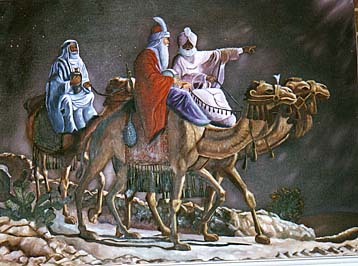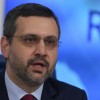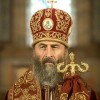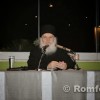 In the troparion for the feast of the Nativity of Christ we sing: “those who worshipped the stars were taught by a star to adore thee”. In the nativity account according to the Gospel of Matthew we read that when Christ was born there appeared an overwhelmingly bright star in the east. While off in the distance, wise men from the east, or Magi, notice the star and begin to follow it towards Jerusalem. The visit of the Magi is the subject of many legends, many emanating from the Western world. What, then is the true account of this visitation?
In the troparion for the feast of the Nativity of Christ we sing: “those who worshipped the stars were taught by a star to adore thee”. In the nativity account according to the Gospel of Matthew we read that when Christ was born there appeared an overwhelmingly bright star in the east. While off in the distance, wise men from the east, or Magi, notice the star and begin to follow it towards Jerusalem. The visit of the Magi is the subject of many legends, many emanating from the Western world. What, then is the true account of this visitation?
The biblical account of the Magi appears only in the Gospel of Matthew: “Now when Jesus was born in Bethlehem of Judea in the days of Herod the king, behold, wise men from the East came to Jerusalem saying . where is he who has been born king of the Jews? For we have seen his star in the East, and have come to worship him” ( Matthew 2:1-2).
The word Magi comes from the Greek word magoi, meaning “astrologer” or “magician”. By the time of the birth of Christ, the Magi were an already well-established and ancient upper class of people from the Persian Empire in today’s northern Iran. The Magi were pagan priests, specializing in astrology and the interpretation of dreams. Skilled in philosophy, medicine and natural science, they became the scholars of Persian society. The Holy Fathers held the tradition that the Magi, although pagans, were deeply religious priest-philosophers who collected wisdom from wherever they could get it. Because the Magi had direct contact with those Hebrews who remained in the east following the Babylonian captivity, they would have surely been familiar with their prophecies of a savior king, and especially the
words of the Mesopotamian prophet Barlaam which we read in Numbers 24:17, and are reflected in The Canon of the Nativity, ode 4: “Thou hast filled the stargazers with joy, O Lord. They knew the hidden meaning of the Prophet Barlaam’s words: ” Thou hast made the star of Jacob to rise.”
Although they were not “kings” in the sense that they are perceived by western legends, the Magi were regarded as men of aristocratic rank even in Jerusalem, which is made apparent by their easy access to King Herod’s court. As we read in the Gospel of Matthew, Herod the Great, known for his cruelty, summoned the Magi because their inquiries into the birth aroused his jealousy, and Herod wanted to
use them to locate Christ in order that he may have him killed. After leaving Herod, the star once again appears to the Magi, as we read: ” ..the star, which they had seen in the East, went before them, until it came to rest over the place where the child was” (Matthew 2:9)
Following the star again, the Magi arrive in Bethlehem bearing gifts for the newborn King. Matthew writes in his gospel: “. . . and going into the house they saw the child with Mary His mother, and they fell down and worshiped Him. Then, opening their treasures, they offered Him gifts, gold and frankincense and myrrh.” (2:11). St. Matthew does
ot mention the names of the Magi, but through the Holy Tradition of
he Church we know them as Saints Gaspar, Melchior and Balthasar. They were baptized into the Christian faith many years later by the Apostle Thomas, who was on his way to preach the Gospel in India. Their relics were brought from Persia to Constantinople in the fourth century by St. Helen (the mother of the Emperor Constantine), then were transferred in the fifth century to Milan and then, finally in
1146 to Cologne Cathedral in Germany were they remain today.
The number and type of gifts bought to Christ by the Magi are not oincidental. Perhaps the three gifts were a type of the Holy Trinity; or symbolize the triune nature of Christ’s ministry: prophetic, royal and priestly; or perhaps it is an expression of the three parts of the nature of man: spirit, soul, and body. The significance of the gifts themselves bears mentioning, as gold is fit to offer a king, and Christ’s two natures are revealed in the offering of frankincense fit to offer God, and myrrh, for a man who is to suffer and die.
What of the star itself ? Many attempts have been made by scholars to give some sort of scientific explanation for the Star of Bethlehem. Indeed, there is substantial historic and scientific evidence of an unusual celestial event at the approximate time of the birth of Christ, yet even this would not explain the behavior of the star as described by the Holy Scriptures. Of course, to the Church
here is a more mystical approach.
The Holy Fathers tell us that this star can be compared to the iraculous pillar of fire, which stood in the camp by night during Israel’s Exodus, or the light from heaven, which overwhelmed Saul on his way to amascus. St John Chrysostom, in his Homily on the second chapter of Matthew, says God called the wise men by the things that are familiar to them, for being astrologers they were naturally astonished at such a large star. He says that God , for the salvation of those in error, allowed himself to be served by astrology, normally used to serve the devil, so that he might gently draw the Magi away from their customs and lead them toward a higher wisdom.
St. Maximos the confessor says that when the intellect is illumined by the infinite Light of God it becomes insensible to everything made by Him, just as the eye becomes insensitive to the stars when the sun
rises. The Magi did not just drop off their gifts and leave, for they left from the presence of Christ as men forever changed by their experience. Their superior intellect and knowledge was confounded by the presence of a little child born under the humblest circumstances.
St. Tikhon, the Patriarch of Moscow, once said that the Nativity of Christ communicated to people an understanding of God, and one’s self, and the purpose of life. He tells us that in celebrating this joyous feast, we must bring into our life the Light of Knowledge, appearing as a star, and guiding us to Christ.
Brothers and Sisters, In keeping this great feast of the Nativity of our Lord, we must receive this Light with joy, not putting it away at the end of the season, but rather Let your light so shine before men, that they may see your good works, and glorify your Father which is in heaven. (Mat.5:16).
CHRIST IS BORN!
GLORIFY HIM!
















